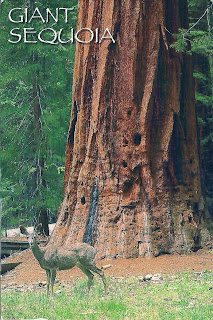 GIANT SEQUOIA
GIANT SEQUOIA
SIERRA NEVADA MOUNTAINS, CALIFORNIA
The giant sequoia are the largest living things on earth. They can be seen in the greatest numbers in Cavaleras Big Trees State Park and Kings Canyon, Sequoia and Yosemite National Parks. The deer in the foreground is a mule deer.
Sent by
Heather, a postcrosser from USA.
This is from Wikipedia :
Sequoiadendron giganteum (giant sequoia, Sierra redwood, Sierran redwood, or Wellingtonia) is the sole living species in the genus Sequoiadendron, and one of three species of coniferous trees known as redwoods, classified in the family Cupressaceae in the subfamily Sequoioideae, together with Sequoia sempervirens (Coast Redwood) and Metasequoia glyptostroboides (Dawn Redwood). The common use of the name "sequoia" generally refers to Sequoiadendron, which occurs naturally only in groves on the western slopes of the Sierra Nevada Mountains of California.
The genus Sequoiadendron includes a single extinct species, S. chaneyi.
Giant Sequoias are the world's largest trees in terms of total volume (technically, only 7 living Giant Sequoia exceed the 42,500 cubic feet (1,200 m3) of the Lost Monarch Coast Redwood tree; see Largest trees). They grow to an average height of 50–85 metres (160–279 ft) and 6–8 metres (20–26 ft) in diameter. Record trees have been measured to be 94.8 metres (311 ft) in height and 17 metres (56 ft) in diameter. The oldest known Giant Sequoia based on ring count is 3,500 years old. Sequoia bark is fibrous, furrowed, and may be 90 centimetres (3.0 ft) thick at the base of the columnar trunk. It provides significant fire protection for the trees. The leaves are evergreen, awl-shaped, 3–6 mm long, and arranged spirally on the shoots. The seed cones are 4–7 cm long and mature in 18–20 months, though they typically remain green and closed for up to 20 years; each cone has 30-50 spirally arranged scales, with several seeds on each scale giving an average of 230 seeds per cone. The seed is dark brown, 4–5 mm long and 1 mm broad, with a 1 mm wide yellow-brown wing along each side. Some seed is shed when the cone scales shrink during hot weather in late summer, but most seeds are liberated when the cone dries from fire heat or is damaged by insects.
Giant sequoia regenerates by seed. Trees up to about 20 years old may produce stump sprouts subsequent to injury. Giant sequoia of all ages may sprout from the bole when old branches are lost to fire or breakage, but (unlike coast redwood) mature trees do not sprout from cut stumps. Young trees start to bear cones at the age of 12 years.
At any given time, a large tree may be expected to have approximately 11,000 cones. The upper part of the crown of any mature Giant Sequoia invariably produces a greater abundance of cones than its lower portions. A mature giant sequoia has been estimated to disperse from 300,000-400,000 seeds per year. The winged seeds may be carried up to 180 m (600 ft) from the parent tree.
Lower branches die fairly readily from shading, but trees less than 100 years old retain most of their dead branches. Trunks of mature trees in groves are generally free of branches to a height of 20–50 m, but solitary trees will retain low branches.
































